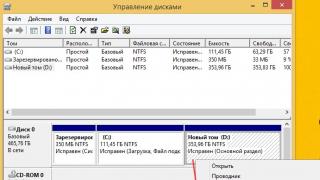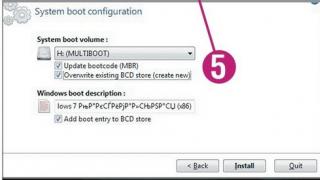Among the computer's slowdowns and freezes, there is one unpleasant feature associated with hard drives: you seem to be working with the hard drive, everything is fine for a while, and then you access it again (open a folder, or start a movie or game), and the computer freezes for 1-2 seconds . (at this time, if you listen, you can hear the hard drive starting to spin up) and a moment later the file you are looking for starts...
By the way, this often happens with hard drives when there are several of them in the system: the system drive usually works fine, but the second drive often stops when inactive.
This moment is very annoying (especially if you do not save energy, and this is justified only in laptops, and even then not always). In this article I will tell you how I get rid of this “misunderstanding”...
Setting up Windows power options
The first thing I recommend starting with is making the optimal power settings on your computer (laptop). To do this, enter the Windows Control Panel, then open the “Hardware and Sound” section, and then the “Power Options” subsection (as in Fig. 1).

The next step is to open the “Hard Drive” tab and set the hard drive shutdown time after 99999 minutes. This means that during idle time (when the PC is not working with the disk) the disk will not stop until the specified time has passed. Which is exactly what we need.

I also recommend turning on maximum performance and disabling energy saving. After setting these settings, restart the computer and see how the disk works - does it stop as before? In most cases, this is enough to get rid of this “error”.
Utilities for optimal energy saving/performance
This applies more to laptops (and other compact devices); PCs usually don’t have this...
Along with the drivers, often on laptops, there is some kind of utility for saving electricity (so that the laptop runs longer on battery power). Such utilities are often installed together with drivers in the system (the manufacturer recommends them, almost as a mandatory installation).
For example, one of these utilities is installed on one of my laptops (Intel Rapid Technology, see Fig. 4).

To disable its influence on the hard drive, just open its settings (tray icon, see Fig. 4) and turn off auto-power management of hard drives (see Fig. 5).

Often, such utilities can be completely removed, and their absence will not have any effect on the work...
APM hard drive power saving parameter: manual adjustment...
There are 2 parameters for hard drives, such as AAM (responsible for the rotation speed of the hard drive. If there are no requests to the HDD, then the drive stops (thereby saving energy). To eliminate this point, you need to set the value to the maximum - 255) and APM (determines the speed of movement of the heads, which often make noise at maximum speed. To reduce noise from the hard drive, the parameter can be reduced; when you need to increase the operating speed, the parameter must be increased).
These parameters cannot be configured just like that; for this you need to use special ones. utilities. One of these is quietHDD.
quietHDD
Website: sites.google.com/site/quiethdd/
A small system utility that does not require installation. Allows you to manually change the AAM, APM parameters. Often these settings are reset after rebooting the PC - which means the utility needs to be configured once and placed in startup (article about autostart in Windows 10 - .
Sequence of actions when working with quietHDD:
1. Run the utility and set all values to maximum (AAM and APM).

3. Create a task in the task scheduler.
Hard drive problems are an extremely serious problem associated with the risk of losing important data and information. That is why you should be extremely careful about any malfunctions in order to prevent their removal.
A typical problem that users deal with is the hard drive turning off during operation. Most often this is manifested by the disappearance of the folder structure from the “My Computer” section. Let's look at several reasons for such situations and try to eliminate them in an accessible way.
Poor cable contact
The SATA cable connector is not particularly reliable, which is why it can lose contact even due to slight vibrations. This leads to the consequences described above.
So, what should you do to prevent your hard drive from turning off? First of all, to solve this problem you need to check the connection. It is possible that contact was lost when connecting to the motherboard or the drive itself. You should also pay attention to the location of connection to the power source.

Remember that the SATA cable cannot be bent more than 90 degrees, so never fold it. If you did this, then it could have deteriorated and will need to be replaced with a new one.
It should also be said about the low-quality power supply connectors for SATA drives, which are prone to deformation and swelling. This very often leads to poor quality contact. The hard drive, of course, works, but at the same time it will think about it, as in the case of existing bad sectors. Therefore, make sure that the connectors are in order and properly connected to the socket.
Overheat
Another extremely common cause of a variety of PC problems. If your hard drive is full and reappears after you restart your computer, it may. To check the temperature, you can use special utilities, of which there are a huge variety today, for example HDTune, AIDA64 and others. With their help, you can find out the parameters you require for certain components.

The normal operating temperature is 30 degrees, the maximum permissible is no more than 45. If your temperature is higher, that is, the propeller overheats, then you should urgently take measures to improve the cooling system:

Power supply (PSU)
Its unstable operation or lack of power often leads to problems with the drives and to the fact that it periodically turns off. Usually this is also accompanied by frequent involuntary computer reboots.

If you have this symptom, try changing the power supply. Why is this necessary? It is likely that this is where the whole problem lies.
Drive failure
If all of the above did not help and the hard drive still periodically disappears, then perhaps the reason is in itself. First of all, check it on . If they are not found, move on to the next step.

HDD serviceability. To check this, connect it to another computer. If nothing changes, then the hard drive is broken and must be replaced. In a situation that arises, the first thing to do is take care of the information stored on it. Try copying it to another medium while yours is still somewhat functional, otherwise you may lose it. Of course, experienced specialists with the appropriate knowledge will help you restore it if something happens, but you shouldn’t take risks.

If the hard drive works fully on another PC, then the problem may be in some other component. Pay attention to the motherboard, which affects its functioning and, in case of problems, can interfere with it. In this case, repairing or replacing it will fix everything.

Power settings in Windows OS
It also often happens that the drive turns off spontaneously when the computer is actively working. To fix this, you need to set the shutdown time value to “Never” in Windows settings.
Instructions for changing the value on Windows 7/8/10:

Now you know what the problem could be if the drive periodically turns off or disappears, and how to fix it yourself without the help of third-party specialists.
This topic is discussed in more detail in this video.
Sometimes when the computer is running, the hard drive stops after a certain time and when you start to perform some actions on the computer, open a folder or partitions of the hard drive, it starts to start and at the moment it spins up the computer freezes for a few seconds (usually 5 seconds) and during this moment it is impossible to do anything. Naturally, this is terribly annoying and precious time is lost, although these 5 seconds are a little, but still unpleasant.
If you are faced with this problem and your hard drive stops, then most likely the solution to this problem is very simple. But it depends on what operating system you are using. If Windows 7 or XP is installed, the solution may be as follows. You need to check the power mode settings on your computer; perhaps these settings are lost and the time after which the hard drive will turn off is set. To check, go to Start - Control Panel - Hardware and Sound - Power Options. if you have a desktop computer, then the mode should be m,snm installed Balanced.

Then click Power plan settings, then - Change advanced power settings and in the window that opens select: Hard drive - Disconnect the hard drive after. If a value is set, it must be changed to zero or Never.

If the hard drive on the laptop stops and the power saving mode is selected, then in the power plan settings you need to do the same procedure as described above.
Good day everyone.
Among the computer's slowdowns and freezes, there is one unpleasant feature associated with hard drives: you seem to be working with the hard drive, everything is fine for a while, and then you access it again (open a folder, or start a movie or game), and the computer freezes for 1-2 seconds . (at this time, if you listen, you can hear the hard drive starting to spin up) and a moment later the file you are looking for starts...
By the way, this often happens with hard drives when there are several of them in the system: the system drive usually works fine, but the second drive often stops when inactive.
This moment is very annoying (especially if you do not save energy, and this is justified only in laptops, and even then not always). In this article I will tell you how I get rid of this “misunderstanding”...
Windows power settings
The first thing I recommend starting with is making the optimal power settings on your computer (laptop). To do this, log in Windows control panel, then open the “” section, and then the “” subsection Power supply"(as in Fig. 1).
Rice. 1. Hardware and Sound / Windows 10
Rice. 2. Changing circuit parameters
The next step is to open the “Hard disk” tab and set the time to turn off the hard drive through. This means that during idle time (when the PC is not working with the disk) the disk will not stop until the specified time has passed. Which is exactly what we need.
Rice. 3. Turn off the hard drive after: 9999 minutes
I also recommend turning on maximum performance and disabling energy saving. After setting these settings, restart the computer and see how the disk works - does it stop as before? In most cases, this is enough to get rid of this “error”.
Have utilities for optimal energy saving/performance
This applies more to laptops (and other compact devices); PCs usually don’t have this...
Along with the drivers, often on laptops, there is some kind of utility for saving electricity (so that the laptop runs longer on battery power). Such utilities are often installed together with drivers in the system (the manufacturer recommends them, almost as a mandatory installation).
For example, one of these utilities is installed on one of my laptops (Intel Rapid Technology, see Fig. 4).
Rice. 4. Intel Rapid technology (performance and power supply).
To disable its influence on the hard drive, just open its settings (tray icon, see Fig. 4) and turn off auto-power management of hard drives (see Fig. 5).
Rice. 5. Turn off auto power management
Often, such utilities can be completely removed, and their absence will not have any effect on the work...
Power saving parameter APM hard drive: manual adjustment...
There are 2 parameters for hard drives, such as A.A.M.(responsible for the rotation speed of the hard drive. If there are no requests to the HDD, then the disk stops (thereby saving energy). To eliminate this point, you need to set the value to the maximum - 255) and APM(determines the speed of movement of the heads, which often make noise at maximum speed. To reduce noise from the hard drive, the parameter can be reduced; when you need to increase the operating speed, the parameter must be increased).
These parameters cannot be configured just like that; for this you need to use special ones. utilities. One of these is quietHDD.
quietHDD
Sequence of actions when working with quietHDD:
1. Run the utility and set all values to maximum (AAM and APM).
Rice. 6. Planner
3. Create a task in the task scheduler.
PS
If the hard drive tries to “accelerate”, but cannot (often at this moment clicks or grinding noises can be heard), and then the system freezes, and everything repeats in a circle again, you may have a physical malfunction of the hard drive.
The reason the hard drive stops may also be due to power supply (if it is insufficient). But this is a slightly different article...
All the best…



